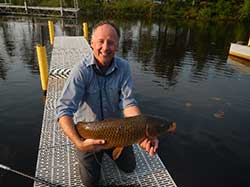Use of Remedial Action Levels and Cleanup Levels with Contaminated Sediment Management
Sponsored by: U.S. EPA, Region 10
Archived: Thursday, January 6, 2022
Use of Remedial Action Levels and Cleanup Levels with Contaminated Sediment Management
2022-01-06
U.S. EPA, Region 10
The purpose of this talk is to understand what Remedial Action Levels (RALs) are and how they are used at contaminated sediment sites. The presentation will also discuss how RALs differ from cleanup levels, and how both are used in the cleanup process. RALs represent concentrations that trigger active construction for sediment cleanup. This can consist of different combinations of dredging, capping, enhanced natural recovery, and monitored natural recovery to address contaminated material at Superfund Sediment Sites and reduce contaminant exposure to human health and the environment. Cleanup levels typically are concentrations that would not pose unacceptable risks to human health and the environment.
Accessibility, Recording, and Content Disclaimer
Rehabilitation Act Notice for Reasonable Accommodation
It is EPA's policy to make reasonable accommodation to persons with disabilities wishing to participate in the agency's programs and activities, pursuant to the Rehabilitation Act of 1973, 29 U.S.C. 791. Any request for accommodation should be made to Jean Balent at 202-566-0832 or balent.jean@epa.gov, preferably one week or more in advance of the webinar, so that EPA will have sufficient time to process the request. EPA would welcome specific recommendations from requestors specifying the nature or type of accommodation needed. Please note that CLU-IN provides both alternate phone call-in options and closed captioning for all webinars, and requests for these specific accommodations are not necessary.
Webinar Recording
By participating in this CLU-IN webinar, you automatically agree to authorize recording of audio and visual content presented during this live event and consent to subsequent use of this recording in the public domain by the U.S. Environmental Protection Agency. This recording may include questions, comments and poll responses provided by you during the live event in addition to your name, voice, image or likeness. This recording will be made available after the conclusion of the live event as part of the CLU-IN webinar archives, and will remain available indefinitely. If you do not wish to consent to the recording, please do not join the live event, and contact Jean Balent at 202-566-0832 or balent.jean@epa.gov to discuss your concerns.
Content Disclaimer
This webinar is intended solely to provide information to the public. The views and opinions expressed as part of this webinar do not necessarily state or reflect those of the U.S. Environmental Protection Agency. It is not intended, nor can it be relied upon, to create any rights enforceable by any party in litigation with the United States, or to endorse the use of products or services provided by specific vendors. With respect to this webinar, neither the United States Government nor any of their employees, makes any warranty, express or implied, including the warranties of merchantability and fitness for a particular purpose, or assumes any legal liability or responsibility for the accuracy, completeness, or usefulness of any information, apparatus, product, or process disclosed, or represents that its use would not infringe privately owned rights.
Presenter:
 Karl Gustavson, Ph.D., U.S. Environmental Protection Agency (gustavson.karl@epa.gov or 703-603-8753)
Karl Gustavson, Ph.D., U.S. Environmental Protection Agency (gustavson.karl@epa.gov or 703-603-8753)
Karl Gustavson is the contaminated sediments team lead and chair of the Contaminated Sediments Technical Advisory Group (CSTAG) in the Superfund program at the U.S. Environmental Protection Agency (EPA). He previously worked for the Army Engineer Research and Development Center where he was stationed at EPA Superfund headquarters advising on contaminated sediment management. At EPA, he specializes in national and site-specific issues regarding contaminated sediment characterization, effects assessment, monitoring, and remediation, and provides technical support at multiple Superfund sites and Great Lakes Areas of Concern. The CSTAG provides formalized review of decisions at a subset of the largest, most complex, and controversial contaminated sediment sites. Dr. Gustavson is involved in several research efforts including on the development of procedures for documenting remedial effectiveness, novel methods to monitor contaminant bioaccumulation, and developing new approaches to reduce contaminant bioaccumulation in fish. Previously, he was a Senior Program Officer for the National Research Council (NRC) of the National Academy of Sciences where he served as the Study Director on reports reviewing Superfund site decision making, assessing the effectiveness of sediment remediation, and evaluating methods to improve chemical risk assessments. His Ph.D. is in Environmental Toxicology from the University of Wisconsin-Madison.
Moderator:
 Jean Balent, U.S. EPA Technology Innovation and Field Services Division (balent.jean@epa.gov or 202-566-0832)
Jean Balent, U.S. EPA Technology Innovation and Field Services Division (balent.jean@epa.gov or 202-566-0832)
Ms Balent is on the staff of the EPA's Technology Innovation and Field Services Division where she has worked to collect and disseminate hazardous waste remediation and characterization information since 2003. Ms Balent manages the Clean Up Information Network website and actively supports online communication and collaboration resources available to EPA. She formerly worked with the US Army Corps of Engineers Environmental Engineering Division in the Buffalo District. Ms Balent was also a member of the SUNY-Buffalo Groundwater Research Group where she constructed and tested large scale models of groundwater flow. Ms Balent has also conducted research relating to the Great Lakes, environmental remediation, and brownfields re-development. She holds a Bachelor's degree in environmental engineering from SUNY-Buffalo and a Master's degree in Information Technology from AIU.
Webinar Slides and References:
Webinar Slides and References:
Additional Resources:
- These materials will be available by Thursday, January 6, 2022
If you have a suggested topic or idea for a future CLU-IN internet seminar, please contact:
Technology Integration and Information Branch
PH: 202-566-0832 | Email: balent.jean@epa.gov
Technology Integration and Information Branch
PH: 202-566-0875 | Email: adam.michael@epa.gov




